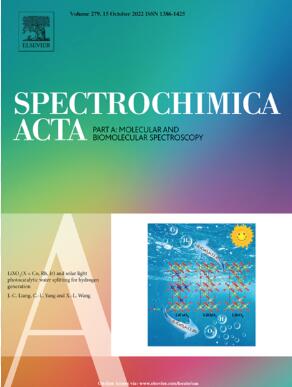Development of fluorescent probe for specific recognition of chiral alanine
IF 4.3
2区 化学
Q1 SPECTROSCOPY
Spectrochimica Acta Part A: Molecular and Biomolecular Spectroscopy
Pub Date : 2025-04-01
DOI:10.1016/j.saa.2025.126155
引用次数: 0
Abstract
Amino acids, the building blocks of life, exhibit significant chirality, whereas L-amino acids predominate in living organisms and play essential roles in protein synthesis and other biochemical processes. Although less abundant, D-amino acids play critical roles in forming bioactive compounds such as peptidoglycans in bacterial cell walls and find applications in the pharmaceutical industry and materials science. This study uses optical detection techniques to develop a chiral fluorescence sensor based on binaphthol (BINOL). We present the design and synthesis of the (R)-5 probe, which exhibits exclusive selectivity for D-alanine (Ala) among the 20 chiral amino acids, with a detection limit of 10.7 nM. The enantioselectivity of the probe was confirmed through fluorescence spectroscopy and visual inspection, demonstrating its potential for detecting and quantifying D-alanine (D-Ala) in biological samples. This work lays the foundation for developing sensitive diagnostic tools that rely on D-amino acid levels.

求助全文
约1分钟内获得全文
求助全文
来源期刊
CiteScore
8.40
自引率
11.40%
发文量
1364
审稿时长
40 days
期刊介绍:
Spectrochimica Acta, Part A: Molecular and Biomolecular Spectroscopy (SAA) is an interdisciplinary journal which spans from basic to applied aspects of optical spectroscopy in chemistry, medicine, biology, and materials science.
The journal publishes original scientific papers that feature high-quality spectroscopic data and analysis. From the broad range of optical spectroscopies, the emphasis is on electronic, vibrational or rotational spectra of molecules, rather than on spectroscopy based on magnetic moments.
Criteria for publication in SAA are novelty, uniqueness, and outstanding quality. Routine applications of spectroscopic techniques and computational methods are not appropriate.
Topics of particular interest of Spectrochimica Acta Part A include, but are not limited to:
Spectroscopy and dynamics of bioanalytical, biomedical, environmental, and atmospheric sciences,
Novel experimental techniques or instrumentation for molecular spectroscopy,
Novel theoretical and computational methods,
Novel applications in photochemistry and photobiology,
Novel interpretational approaches as well as advances in data analysis based on electronic or vibrational spectroscopy.

 求助内容:
求助内容: 应助结果提醒方式:
应助结果提醒方式:


